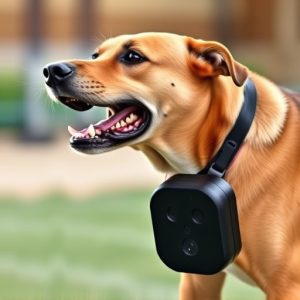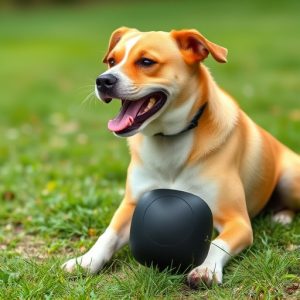Ultrasonic Dog Repellents: Effective Behavior Modification with Optimal Vibration Settings
Canine behavior modification through ultrasonic dog repellent devices is an effective solution for i…….
Canine behavior modification through ultrasonic dog repellent devices is an effective solution for issues like barking and aggression, leveraging a dog's sensitive hearing. These tools emit inaudible high-frequency sounds to communicate and encourage desired behavior without causing harm. The best vibration settings vary by dog breed, size, and sensitivity, with lower frequencies generally safer and more effective for long-term training. Proper use involves starting at the lowest settings, monitoring reactions, and combining with traditional training methods. Strategic placement in problem areas and consistent sessions are key to successful behavior modification using these devices.
“Unleash the power of sound to transform your canine companion’s behavior with our comprehensive guide. This article explores innovative solutions like ultrasonic systems, delving into their effectiveness as dog repellent devices. We dissect the science behind canine response to sound and vibrations, offering insights on optimal settings for training. From understanding your dog’s perspective to selecting the best vibration levels for maximum impact, we provide a roadmap to successful behavior modification. Uncover why these systems are gaining popularity and navigate the market with our expert tips.”
- Understanding Canine Behavior and the Role of Sound
- Introduction to Ultrasonic Dog Repellent Devices
- Factors to Consider When Choosing Vibration Settings
- Effectiveness and Safety: What Research Says
- Best Practices for Using a Canine Behavior Modification Ultrasonic System
Understanding Canine Behavior and the Role of Sound
Canine behavior is a complex interplay of innate instincts, past experiences, and current environmental influences. Understanding these factors is crucial when modifying a dog’s behavior, especially in response to unwanted actions such as barking or aggression. Sound plays a significant role in this process. Dogs have an incredible sense of hearing, capable of detecting sounds well beyond the human range, which means that specific frequencies can capture their attention and elicit certain behaviors.
Ultrasonic systems, designed as dog repellent devices, take advantage of these auditory capabilities. By emitting sounds at optimal vibration settings, these devices can effectively communicate with dogs without causing them harm. The best vibration settings are those that fall within a range that resonates with dogs but remain inaudible to humans. This approach ensures the safety and comfort of both pets and their owners while encouraging desirable behavior through precise auditory cues.
Introduction to Ultrasonic Dog Repellent Devices
Ultrasonic dog repellent devices have emerged as a popular and effective solution for managing canine behavior, especially in residential areas where traditional training methods may face restrictions. These innovative tools utilize high-frequency sound waves, typically beyond the human hearing range, to create an unpleasant sensation for dogs without causing any harm. When activated, the device emits ultrasonic vibrations at specific frequencies that are known to be aversive to canines, effectively deterring unwanted behaviors such as barking, jumping on furniture, or aggressive tendencies.
The effectiveness of these devices lies in their ability to target specific behavior issues and provide a non-confrontational training aid for pet owners. One of the key advantages is the customizable vibration settings, allowing users to adjust the frequency and intensity according to their dog’s sensitivity and the desired behavior change. Finding the best vibration settings involves trial and error, but it ensures that the device is both safe and efficient in modifying canine behavior without causing any discomfort or stress to the pet.
Factors to Consider When Choosing Vibration Settings
When selecting vibration settings for a canine behavior modification ultrasonic system, or dog repellent device, several key factors come into play to ensure optimal effectiveness and animal welfare. The first consideration is the sensitivity of your dog’s hearing. Different dogs have varying levels of auditory acuity, so adjusting the vibration intensity accordingly is crucial. Generally, starting with lower vibrations and gradually increasing as needed allows for a more precise approach, minimizing any potential discomfort or stress for your pet.
Additionally, the context in which the device will be used should guide your choice. Whether it’s indoor training sessions or outdoor deterrence, different environments require adaptable settings. For instance, higher vibrations might be suitable for addressing persistent barking in busy households, while lower levels could be more appropriate for delicate training scenarios to encourage desired behaviors without startling the dog. The best vibration settings for a dog repellent device are those that address specific behavior issues effectively while maintaining a safe and positive learning environment.
Effectiveness and Safety: What Research Says
The effectiveness and safety of canine behavior modification ultrasonic systems, often marketed as dog repellent devices, have been subjects of growing interest in veterinary and behavioral research. Studies suggest that when used appropriately, these devices can be highly effective in modifying unwanted behaviors such as barking, howling, and aggression. The ultrasonic waves emit a high-frequency sound that is generally not audible to humans but can startle or discomfort dogs, encouraging them to cease the behavior.
Research has also shown that safety is a key consideration. Best vibration settings for dog repellent devices vary based on breed, size, and sensitivity of individual dogs. Improper use or setting too high a frequency can cause distress or even physical harm. Professionals recommend conducting thorough research and following manufacturer guidelines closely to ensure the well-being of pets while leveraging these innovative tools for behavior modification.
Best Practices for Using a Canine Behavior Modification Ultrasonic System
When using a canine behavior modification ultrasonic system, it’s crucial to strike a balance between effectiveness and animal welfare. Begin by identifying the specific behavioral issue and setting appropriate vibration levels; lower frequencies are generally better for long-term training as they are less obtrusive and more effective in modifying certain behaviors. Start with the lowest settings and gradually increase as needed, monitoring your dog’s reaction closely. Consistency is key – ensure all household members use the device identically to avoid confusion for the pet. Regular reinforcement of desired behavior with treats or praise is equally important alongside using the ultrasonic system.
For optimal results with a dog repellent device, space is significant. Place the unit strategically in areas where problematic behaviors occur, ensuring it’s directed at the dog’s line of sight and not aimed haphazardly. Maintain regular sessions, as consistent intervention is vital for successful behavior modification. Regularly check the batteries and keep the device clean to maintain its efficiency. Remember, while ultrasonic systems can be effective tools, they should complement traditional training methods rather than replace them entirely.
The canine behavior modification ultrasonic system emerges as a powerful tool in the realm of pet care, offering a safe and effective solution for addressing unwanted behaviors. By harnessing the power of sound, these devices disrupt negative patterns while promoting positive ones. When selecting the best vibration settings, considering factors like dog breed, size, and sensitivity is key. Research consistently supports their effectiveness, demonstrating their ability to deter barking and other nuisance behaviors. Adhering to best practices ensures optimal results, fostering a harmonious relationship between pets and their owners. With the right approach, ultrasonic dog repellent devices can be a game-changer in creating a quieter, more peaceful environment for both dogs and folks living with them.


